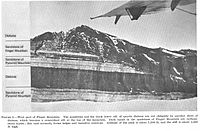
Photo from wikipedia
Although virtual outcrops or digital outcrop model applications in geological studies are becoming increasingly common, virtually no attention has been given to acquisition of palaeocurrent data from cross‐strata. Palaeocurrent indicators… Click to show full abstract
Although virtual outcrops or digital outcrop model applications in geological studies are becoming increasingly common, virtually no attention has been given to acquisition of palaeocurrent data from cross‐strata. Palaeocurrent indicators are abundant in the sedimentary record, mainly as cross‐strata, and present compelling implications for basin analysis, plate tectonics and palaeoenvironmental reconstructions, as well as for sediment transport systems. Palaeocurrents from cross‐strata also comprise a quantifiable parameter in sedimentary successions that can be used in quantitative modelling of depositional architecture with implications for reservoir characterization through outcrop analogue studies. A common obstacle in obtaining large cross‐strata orientation datasets is the limited access to steep and high outcrop faces, as well as financial and time restrictions on field work. To overcome these issues, the simplest workflow for drone‐based acquisition, photogrammetric processing and analysis of virtual outcrops aiming at the attainment of palaeocurrent data from cross‐strata is appraised here. The results show that orientations of cross‐beds measured on virtual outcrops, with and without ground control points, and using two different levels of resolution downsampling, are comparable to field measurements using analogue and electronic devices. Time and financial resources can thus be saved by using the straightforward method presented here to supplement palaeocurrent mapping across wide areas and distinct stratigraphic intervals.
Journal Title: Sedimentology
Year Published: 2021
Link to full text (if available)
Share on Social Media: Sign Up to like & get
recommendations!